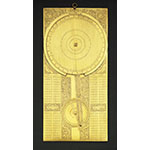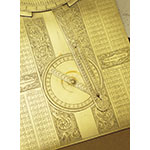Brass instrument, undated and of unknown maker. The Jovilabe is certainly connected to Galileo's efforts to determine the periods of Jupiter's moons—whose discovery he announced in 1610 in Sidereus Nuncius—and to compute the times of their eclipses. Galileo immediately realized that eclipses of Jupiter's moons could provide a precise method to determine the longitude. The instrument is engraved with tables showing the mean motions of each of the four moons. Two connected disks of different diameters are rotated by means of a movable rod. They are used to create a "view from the Sun" of the movements of Jupiter's moons observed from the Earth (movements that seem irregular because of the heliocentric motions of the Earth and Jupiter). Galileo began the systematic study of the periods of Jupiter's moons in 1611, developing a micrometer for the purpose. The Pisan scientist compiled tables of the periods that he offered, with his telescopes, first to the King of Spain (1611, 1612, 1616, and 1627-1628), then to the States General of Holland (1637-1641). To convince his Spanish interlocutors that Jupiter and its moons could be observed on unstable ground, such as a ship's deck, Galileo designed a special helmet carrying a small telescope on a hinged mount. The device was named celatone (celata = "helmet" in Italian). In this second proposal, he also described the advantages of applying the pendulum to the clock. Despite the interest they aroused, neither of his proposals was accepted. Provenance: estate of Leopold de' Medici.











